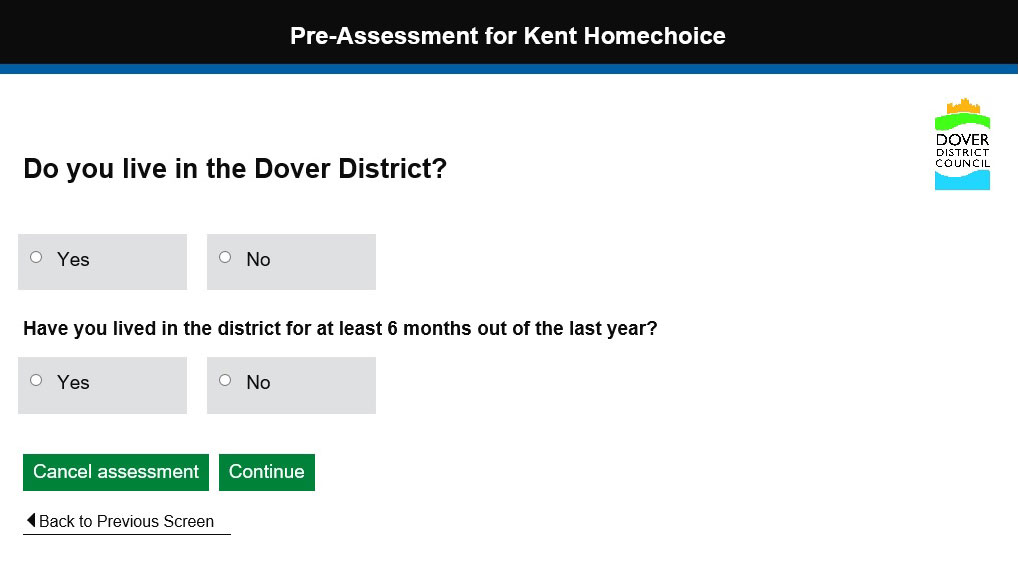What We Say
New form launched using Government Digital Service Design Principles
by Luke HatfieldKent has gone live with a new housing pre-assessment form created by us that provides a simple and accessible format for applicants while seamlessly integrating the 13 different policies underpinning the regional scheme.

The online form has been specially designed for Kent Homechoice – a partnership of 13 local authorities and 25 housing associations – using the latest Government Digital Service Design Principles. This means the new form has been built on a foundation of simple single answer questions, many with straightforward yes/no options. Relevant additional details are gathered with expanded questions based on the specific responses that applicants provide. Highlighted instructions help applicants see the choices they can make as they progress through the form.
The form encompasses a pre-assessment and an action plan including housing options advice. It is fully responsive, so applicants can complete the form on mobile phones, tablets and other mobile devices as well as a laptop or PC. The scheme signed off the form following extensive testing by its customers.
“The form looks fantastic and was launched smoothly and without a single hitch,” said Vicky Hodson, the Kent Homechoice Partnership Manager. “We are delighted with what has been achieved and we now look forward to working on the main online application form.”
The Government Digital Service’s Design Principles ... the new Kent form has been created using these 10 design principles set out by the Government Digital Service:
- 1. Start with user needs
- 2. Do less
- 3. Design with data
- 4. Do the hard work to make it simple
- 5. Iterate. Then iterate again.
- 6. This is for everyone
- 7. Understand context
- 8. Build digital services, not websites
- 9. Be consistent, not uniform
- 10. Make things open: it makes things better
Migration to Microsoft Azure Cloud Services
by Kate NashWhat is Microsoft Cloud? This is Microsofts cloud offering where organisations host their servers is changing from hosting real servers in a data centres to having virtual servers in the cloud.
Where were our servers previously if not in the cloud? Previously, our servers were real servers hosted in a data centre. Our customers have hired Sector to buy and commission the servers and it’s our responsibility to manage and maintain those servers for our customers. This means that we are responsible for the hardware of those server’s as well as the software running on the servers.
Why move to the cloud? The main benefits of switching to virtual servers in the cloud is that we are no longer be responsible for the hardware. This means that we will no longer be vulnerable to hardware failure which was always a possibility before. The cloud also offers a much faster server commissioning time. With real servers we have to order the hardware, wait for it to be delivered, commission the server in the office and then deliver and install the servers in the data centre, which takes days. With virtual servers in the cloud you can spin them up in hours. You can also alter the number of CPUs and the disk drive space substantially faster. With real servers it’s very tricky to change the computing power of a server, you have to buy another server. With virtual servers it’s case of changing the configuration. Similarly with disk space, to increase the disk space on a real server you have to go to the data centre, open up the server and put more physical disks into the server. Which exposes you to risks; one of the few times Sector has experienced a hardware failure was as a consequence of adding more disks. With virtual servers it’s a case of configuring more storage space.
Is Microsoft Cloud the only cloud service? No, there are a number of companies providing cloud space. Some of the big players are Amazon web services, Rackspace hosting, Dimension Data, Google Cloud Platform and many more.
Why choose Microsoft Cloud out of all the other available options? Microsoft’s cloud offering goes a step further than the others do with their Azure Web Apps and Azure SQL databases. Ultimately we would like to use these offerings, so it makes sense to use the Azure virtual machines as a stepping stone to get there. We are predominantly a Microsoft shop, our websites are written in .Net and run on Microsoft’s Internet Information Services (IIS) and our databases are SQL Server databases. This means we can migrate our applications to Azure Web Apps and Azure databases. This is hugely beneficial for us as it means that we no longer have to manage the windows operating system and Microsoft’s software running on the virtual machines, we would only be managing the software we’ve written which is what we’re best at.
How long has the Microsoft Cloud been running for? It has now been running for six years.
If it has been running for 6 years, why have you decided to make the move to the Microsoft Cloud now? As with all new technology, there is a balance between cutting edge and bleeding edge. We believe that the offering is mature enough now for it to be a viable option.
Gloucestershire’s Homeseeker Plus
by Gary HatfieldWe have won a G Cloud Tender process along with our partners Locata Housing Services for the delivery and management of the systems driving the Gloucestershire Homeseeker housing scheme.

The scheme have changed their name and relaunched as Homeseeker Plus, with a new partner, responsive website and upgraded housing system.
West Oxfordshire DC has joined the original six partners to create a scheme that will now reach from the borders of Monmouthshire to the outskirts of Oxford. The six local authorities that formed the original scheme are Cheltenham BC, Cotswold DC, Forest of Dean DC, Gloucester City Council, Stroud DC and Tewkesbury BC.
There are small policy differences across the partners that will be managed seamlessly by the new Locata system. Every partner will enjoy upgraded services with West Oxfordshire moving to a digital platform for the first time.
Homeseeker Plus was also particularly keen to take advantage of our Homelessness Prevention and Advice (HPA2) system with its fast and precise HCLIC report generator.
The G Cloud Tender process allows schemes to choose and buy services covering infrastructure, platform, software and specialist cloud services from companies that have been vetted and approved by the Crown Commercial Service. The process significantly cuts the time, effort and costs incurred by public sector organisations wishing to buy services from the private sector.
Three more schemes go live with Mobile App
by Luke HatfieldThree more schemes are now live with the Mobile App that helps customers bid for homes.

Monmouthshire, First Choice Homes Oldham and Cheshire West & Chester have joined existing users Kent and West London in using a bespoke mobile app that is individually branded to their own standards.
Customers can download the app from Google Play (Android version) and the Apple ITunes App Store. The app allows applicants to bid for available social housing in the area, gives feedback on previous bids and allows contact details to be updated.
The mobile app has already proved very successful. In Kent, where the mobile app has been live for more than two years it is now the most popular form of bidding.
